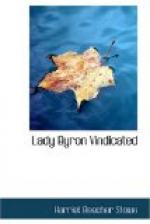Subsequently, she also related to me the other story of the parting-scene between Lord and Lady Byron. In regard to these two incidents, my recollection is clear.
It will be observed by the reader that Lady Byron’s conversation with me was simply for consultation on one point, and that point whether she herself should publish the story before her death. It was not, therefore, a complete history of all the events in their order, but specimens of a few incidents and facts. Her object was, not to prove her story to me, nor to put me in possession of it with a view to my proving it, but simply and briefly to show me what it was, that I might judge as to the probable results of its publication at that time.
It therefore comprised primarily these points:—
1. An exact statement, in so many words, of the crime.
2. A statement of the manner in which it was first forced on her attention by Lord Byron’s words and actions, including his admissions and defences of it.
3. The admission of a period when she had ascribed his whole conduct to insanity.
4. A reference to later positive evidences of guilt, the existence of a child, and Mrs. Leigh’s subsequent repentance.
And here I have a word to say in reference to the alleged inaccuracies of my true story.
The dates that Lady Byron gave me on the memoranda did not relate either to the time of the first disclosure, or the period when her doubts became certainties; nor did her conversation touch either of these points: and, on a careful review of the latter, I see clearly that it omitted dwelling upon anything which I might be supposed to have learned from her already published statement.
I re-enclosed that paper to her from London, and have never seen it since.
In writing my account, which I designed to do in the most general terms, I took for my guide Miss Martineau’s published Memoir of Lady Byron, which has long stood uncontradicted before the public, of which Macmillan’s London edition is now before me. The reader is referred to page 316, which reads thus:—
’She was born 1792; married in January 1814; returned to her father’s house in 1816; died on May 16, 1860.’ This makes her married life two years; but we need not say that the date is inaccurate, as Lady Byron was married in 1815.
Supposing Lady Byron’s married life to have covered two years, I could only reconcile its continuance for that length of time to her uncertainty as to his sanity; to deceptions practised on her, making her doubt at one time, and believe at another; and his keeping her in a general state of turmoil and confusion, till at last he took the step of banishing her.
Various other points taken from Miss Martineau have also been attacked as inaccuracies; for example, the number of executions in the house: but these points, though of no importance, are substantially borne out by Moore’s statements.




